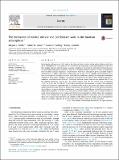Files in this item
The formation of sulfate, nitrate and perchlorate salts in the martian atmosphere
Item metadata
| dc.contributor.author | Smith, Megan L. | |
| dc.contributor.author | Claire, M.W. | |
| dc.contributor.author | Catling, D.C. | |
| dc.contributor.author | Zahnle, K.J. | |
| dc.date.accessioned | 2014-05-13T15:31:02Z | |
| dc.date.available | 2014-05-13T15:31:02Z | |
| dc.date.issued | 2014-03-01 | |
| dc.identifier.citation | Smith , M L , Claire , M W , Catling , D C & Zahnle , K J 2014 , ' The formation of sulfate, nitrate and perchlorate salts in the martian atmosphere ' , Icarus , vol. 231 , pp. 51-64 . https://doi.org/10.1016/j.icarus.2013.11.031 | en |
| dc.identifier.issn | 0019-1035 | |
| dc.identifier.other | PURE: 118183237 | |
| dc.identifier.other | PURE UUID: 50e4b688-f8cc-4c18-a077-f668134434a0 | |
| dc.identifier.other | Scopus: 84891095152 | |
| dc.identifier.other | ORCID: /0000-0001-9518-089X/work/34103244 | |
| dc.identifier.other | WOS: 000331668100005 | |
| dc.identifier.uri | https://hdl.handle.net/10023/4778 | |
| dc.description | Funding: 2011 NAI Director’s Discretionary Fund award titled ‘‘Perchlorate, Water, and Life’’, along with a NASA postdoctoral program award to work at the Virtual Planetary Laboratory. | en |
| dc.description.abstract | In extremely arid regions on Earth, such as the Atacama Desert, nitrate, sulfate and perchlorate salts form in the atmosphere and accumulate on the surface from dry deposition according to diagnostic evidence in their oxygen isotopes. Salts of similar oxyanions should have formed in the atmosphere of Mars because of comparable photochemical reactions. We use a 1-D photochemical model to calculate the deposition rates of sulfate, nitrogen oxyanions, and perchlorate from Mars' atmosphere, given a plausible range of volcanic fluxes of sulfur- and chlorine-containing gases in the past. To calculate integrated fluxes over time, we assume that throughout the last 3. byr (the Amazonian eon), the typical background atmosphere would have been similar to today's cold and dry environment. If the soil has been mixed by impact perturbations to a characteristic depth of ~2. m during this time, given a time-average volcanic flux 0.1% of the modern terrestrial volcanic flux, the model suggests that the soil would have accumulated 1.0-1.7. wt.% SO42- and 0.2-0.4. wt.% N in the form of pernitrate (peroxynitrate) or nitrate. The calculated sulfate concentration is consistent with in situ observations of soils from rovers and landers and orbital gamma ray spectroscopy. However, nitrates or pernitrates are yet to be detected. The modeled formation of perchlorate via purely gas-phase oxidation of volcanically-derived chlorine is insufficient by orders of magnitude to explain 0.4-0.6. wt.% ClO4- measured by NASA's Phoenix Lander. The far smaller amount of ozone in the martian atmosphere compared to the terrestrial atmosphere and the colder, drier conditions are the cause of lower rates of gas phase oxidation of chlorine volatiles to perchloric acid. Our calculations imply that non-gas-phase processes not included in the photochemical model, such as heterogeneous reactions, are likely important for the formation of perchlorate and are yet to be identified. | |
| dc.format.extent | 14 | |
| dc.language.iso | eng | |
| dc.relation.ispartof | Icarus | en |
| dc.rights | © 2013 The Authors. Published by Elsevier Inc. All rights reserved. This is an open-access article distributed under the terms of the Creative Commons Attribution License, which permits unrestricted use, distribution, and reproduction in any medium, provided the original author and source are credited | en |
| dc.subject | Mars | en |
| dc.subject | Mars, atmosphere | en |
| dc.subject | Photochemistry | en |
| dc.subject | Atmosphere, chemistry | en |
| dc.subject | Mars, surface | en |
| dc.subject | QB Astronomy | en |
| dc.subject | GE Environmental Sciences | en |
| dc.subject.lcc | QB | en |
| dc.subject.lcc | GE | en |
| dc.title | The formation of sulfate, nitrate and perchlorate salts in the martian atmosphere | en |
| dc.type | Journal article | en |
| dc.description.version | Publisher PDF | en |
| dc.contributor.institution | University of St Andrews. University of St Andrews | en |
| dc.contributor.institution | University of St Andrews. Earth and Environmental Sciences | en |
| dc.contributor.institution | University of St Andrews. St Andrews Isotope Geochemistry | en |
| dc.identifier.doi | https://doi.org/10.1016/j.icarus.2013.11.031 | |
| dc.description.status | Peer reviewed | en |
| dc.identifier.url | http://www.scopus.com/inward/record.url?eid=2-s2.0-84891095152&partnerID=8YFLogxK | en |
This item appears in the following Collection(s)
Items in the St Andrews Research Repository are protected by copyright, with all rights reserved, unless otherwise indicated.

